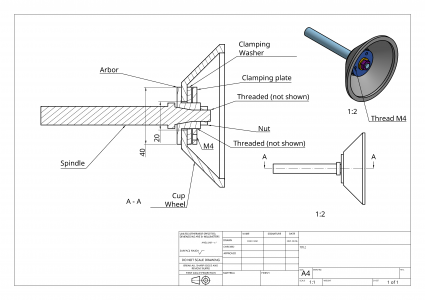What way did you go with the wheel mounting arbours/collets, out of interest?
Not sure I understand the question.
I had to remake my spindle (long story).
You really should cut the taper on the spindle and on the arbors without moving the compound in between operations. The taper in the spindle is cut by holding the bearing box in a steady rest and driving the spindle from the chuck. I think you try to make all the arbors you'll ever need in one sitting. The goal is to dedicate arbors of various sizes to the different wheels you plan to use, so you have to plan ahead on specific dimensions.
I need to do all of that, build a base and some storage, paint (shudder), and add a couple of 220V outlets at convenient places in my shop. I should really swap out for a 110V single-phase motor for convenience sake, but I can't decide which is more effort (the 230V motor came with the UK kit).
For work-holding, I'm planning to use ER collets but would really like to see if I can figure out a way to mount a Gorton spindle to hold Gorton-taper tooling. I can grind round (or square!) tools in the ER collets but either need to make a holder for tapered engraving bits, or figure out a way to mount a Gorton spindle. Engraving is incredibly fiddly for fine work, and grinding the tools in-situ rather than in a separate holder would obviously be more precise, so I'd rather figure out how to mount a Gorton spindle if I can.
The funniest bit about getting the thing to this point is how much better it's made me at free-hand grinding various cutters!
I'm actually comfortable with free-hand grinding lathe bits and most one-off tools, but some tiny cutters and especially engraving bits just can't be ground without a T&C grinder or some sort of jig/fixture.
I'm not exactly the first to have noticed how handy a Quorn would be to grind the cutters necessary to make a Quorn! I broke a handful of hand-ground trepanning bits cutting the labyrinth seals in the spindle caps, for example.


